The square root is easily extracted with a calculator. To do this, just type the original number on it and press the root key ![]()
If you don't have a calculator handy, you extract the square root using the algorithm for extracting the square root.
Application of the algorithm can be very useful for tests and exams. After all, most often at such events it is forbidden to use a calculator.
How to use the algorithm
Let's look at the application of the square root extraction algorithm using concrete examples. We'll talk later about why the algorithm should be applied in this way.
Example 1. Extract the square root of 4096 using the square root extraction algorithm.
First of all, let's group the number 4096 by two digits. Moving from the end to the left, make a small marker:
![]()
The grouped digits of the original number are called facets, and the grouping itself by two digits is called a Facets division. The number of facets suggests how many digits the extracted root will contain. In our example, the extracted root will contain two digits, since the original number contains two facets.
Now we need to extract the square root of the number 40 to integers, so we get 6. Write 6 after the equal sign:
![]()
Then we square the number 6 and write the result under the number 40

Then we subtract the number 36 from the number 40 and get 4. Write this number under 36
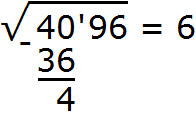
We remove the remaining digits from under the root, namely 96. The remainder is 496
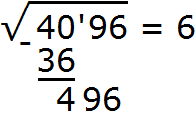
Now you need to find the next digit of the root. This is found as follows. The first found digit of the root, namely 6 multiplied by 2, we get 12. To the number 12 at the end of the need to add another digit (this figure later and will be the next digit of the root) and multiply the resulting number by the same added digit. The resulting product must be equal to the remainder 496 or at least as close to it as possible, but not exceeding it.
So, for example, let's check the number 5. Add it to number 12 and multiply the resulting number 125 by 5.

The resulting number is 625, which is greater than the remainder 496. So the number 5 is not suitable as the next digit of the root. Then let's check the number 4. Add it to number 12 and multiply the resulting number 124 by 4

The result is 496, which is exactly our residue. So the digit 4 added to the number 12 is the next digit of the root. Go back to the original example and write number 4 in the answer after number 6
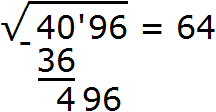
And the number 496, which is the result of multiplying 124 by 4, we write under the remainder 496

Subtract 496 - 496 = 0. Zero in the remainder indicates that the solution is complete:
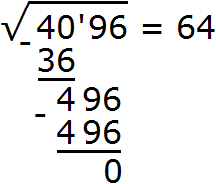
For the convenience of finding the second digit, a vertical line is drawn to the left of the remainder and the multiplication is written behind this line. In our case, multiplication 124 by 4. The result of multiplication is immediately written under the remainder:
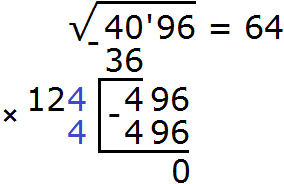
So the square root of 4096 is 64
![]()
Example 2. Extract the square root of the number 441 using the square root extraction algorithm.
First of all, let's group the number 441 by two digits. Moving from the end to the left, make a small mark. In this case, the number 441 has only three digits. Therefore, we group the digits 4 and 1. The last four on the left will be by itself:
![]()
Now we need to extract the square root of the number 4 to integers, so we get 2. Write 2 after the equal sign:
![]()
Then we square the number 2 and write the result under the number 4

Subtract 4 from the number 4 to get 0. It is customary not to write the zero. Remove the remaining digits of the root, namely 41
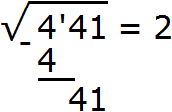
Now find the next digit of the root. The first digit of the root, 2, is multiplied by 2 to get 4. To the number 4 at the end you need to add another digit (this digit will later become the next digit of the root) and multiply the resulting number by the same added digit. The resulting product must be equal to the remainder of 41 or at least as close to it as possible, but not exceeding it.
So, for example, let's check the number 2. Add it to the number 4 and multiply the resulting number 42 by the same added digit 2. The result of multiplication will be written directly under the remainder 41
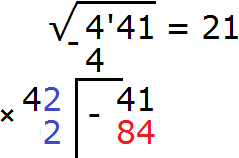
The resulting number is 84, which is greater than the remainder of 41. So the number 2 is not suitable as the next digit of the root. Then let's check the number 1. Add it to number 4 and multiply the resulting number 41 by the same extra digit 1
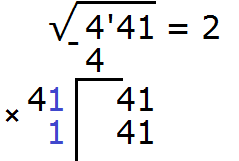
We got number 41, which is exactly our residue. So the digit 1 added to number 4 is the next digit of the root. Write the digit 1 after the digit 2
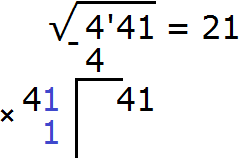
And the number 41, which is the result of multiplying 41 by 1, we write under the remainder 41
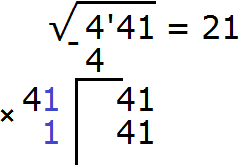
Subtract 41 - 41 = 0. Zero in the remainder indicates that the solution is complete:
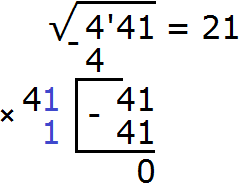
Example 3: Extract the square root of the number 101761 using the square root extraction algorithm.
We break the number 101761 into facets:
![]()
The result is three facets. So the root will consist of three digits.
Extract the square root of the first facet (of number 10) to integers, we get 3. Write 3 after the equal sign:
![]()
Next, square the number 3 and write the result under the first facet (under the number 10)

Subtract 9 from 10 and get 1. Drop the next facet, namely the number 17. The remainder is 117
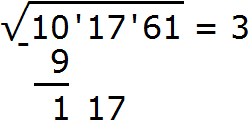
Now find the second digit of the root. The first found digit of the root, namely 3 multiplied by 2, we get 6. Add another digit to the number 6 at the end (this digit will later become the second digit of the root) and multiply the resulting number by the same added digit. The resulting product must be equal to the residue 117 or at least as close to it as possible, but not exceeding it.
So, for example, let's check the number 2. Add it to the number 6 and multiply the resulting number 62 by the same added digit 2. The result of multiplication will be written directly under the remainder 117
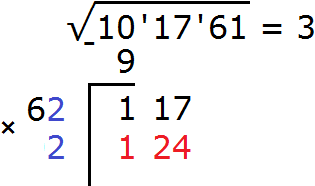
The result is 124, which is greater than the remainder of 117. So the number 2 is not suitable as the second digit of the root. Then let's check the number 1. Add it to number 6 and multiply the resulting number 61 by the same digit 1
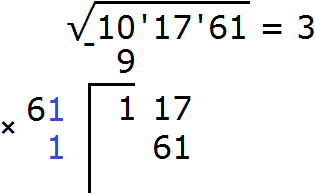
The result is 61, which does not exceed the remainder of 117. So the digit 1 added to the number 6 is the second digit of the root. Write it in the answer after number 3
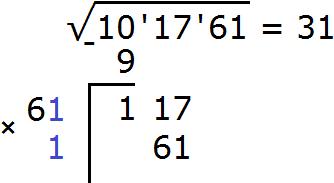
Now subtract 117 - 61 = 56.

We drop the next facet, namely the number 61. We obtain a new remainder 5661
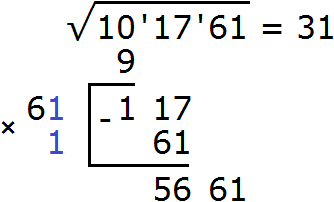
Now find the third digit of the root. The first two found digits of the root, namely the number 31 multiplied by 2, we get 62. To the number 62 at the end add another digit (this digit will later become the third digit of the root) and multiply the resulting number by the same added digit. The resulting product must be equal to the residue 5661 or at least as close to it as possible, but not exceeding it.
So, for example, let's check the number 9. Add it to the number 62 and multiply the resulting number 629 by the same added digit 9. The result of multiplication will be written directly under the remainder 5661

We got the number 5661, which is exactly our remainder. So the digit 9 added to the number 62 is the third digit of the root. Write number 9 in the answer after number 1
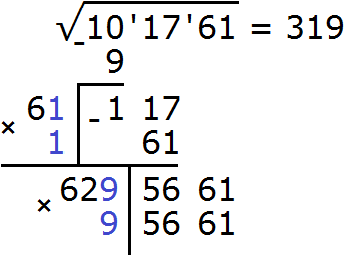
Subtract 5661 - 5661 = 0. Zero in the remainder indicates that the solution is complete:
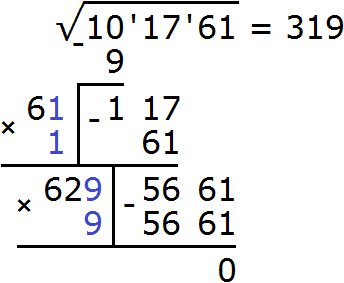
Example 4: Extract the square root of 30.25 using the square root extraction algorithm.
This number is a decimal. In this case, the facet should divide the integer part and the fractional part.The integer part on the face should be divided by moving to the left of the point. And the fractional part moves to the right of the point:
![]()
You have one facet in each part. This means that the root will consist of two digits: one digit in the integer part of the root and one digit in the fractional part.
Extract the square root from the first face (from the number 30) to integers, we obtain 5. Write 5 after the equal sign:
![]()
Next, square the number 5 and write the result under the first facet (under the number 30)

Subtract the number 25 from the number 30 to get 5.
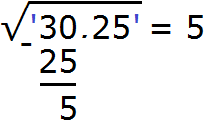
The extraction of the root from the integer part of the underlying expression is complete. At this point, we have extracted the root of 30.25 to the nearest whole number, and obtained an answer of 5. The last remainder of 5 shows that the integer part of 30 exceeds the square of 52 by 5 square units.
To further extract the root (to the nearest tenth), take down the next facet, namely the number 25, we get the remainder 525. And in the answer after number 5 you should put a dot, because now we are going to look for the fractional part of the root.
Then we take down the next facet, which is the number 25. The remainder is 525

Next, we work on the same principle as before. Find the next digit of the root. To do this, we multiply the already found root, namely the number 5 by 2 to get 10. To the number 10 at the end add another digit (this digit will later become the next digit of the root) and multiply the resulting number by the same added digit. The resulting product must be equal to the remainder of 525 or at least as close to it as possible, but not exceeding it.
So, for example, let's check the number 5. Add it to number 10 and multiply the resulting number 105 by the same added digit 5

We got the number 525, which is exactly our remainder. So the digit 5 added to the number 10 is the next digit of the root. Go back to the original example and write the number 5 after in the answer after the dot:
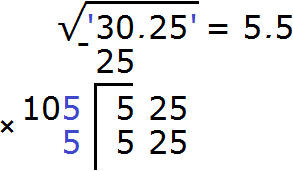
Subtract 525 - 525 = 0. Zero in the remainder indicates that the solution is complete:
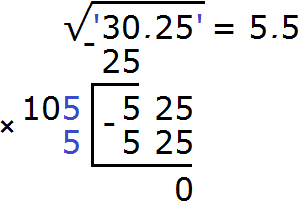
The following technique could be used in the sub-rooted expression: multiply the sub-rooted number by 100 and get the number 3025 under the root. Then extract the square root from it, as from an ordinary integer. The answer would then be 55

Then you can divide 3025 back by 100 (or move the point to the left by two digits). The result will be the same number 30.25 under the root, and the right side will be reduced by a factor of ten to get the square root of 30.25.
Example 5. Extract the square root of the number 632.5225 using the square root extraction algorithm.
This number is a decimal. Divide the number into facets. The integer part and the fractional part should be divided on the facets.The integer part on the face should be divided by moving to the left of the point. And the fractional part by moving to the right of the point:
![]()
The result is four facets. There are two facets in the integer part, and two facets in the fractional part. This means that the root will consist of four digits: two digits will be in the integer part of the root, and two digits after the decimal point.
Extract the square root of the first facet (of number 6) to integers, we get 2. Write 2 after the equal sign:
![]()
Next, square the number 2 and write the result under the first facet (under the number 6)

Subtract the number 4 from the number 6 to get 2. Then we take down the next facet, namely the number 32. The remainder is 232.
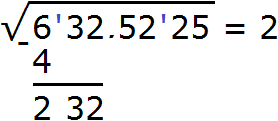
Now find the second digit of the root. The first digit of the root, 2, is multiplied by 2, so you get 4. To the number 4 at the end you need to add another digit (this digit will later become the second digit of the root) and multiply the resulting number by the same added digit. The resulting product must be equal to the residue 232 or at least as close to it as possible, but not exceeding it.
So, for example, let's check the number 6. Add it to the number 4 and multiply the resulting number 46 by the same added digit 6. The result of multiplication will be written immediately under the remainder 232
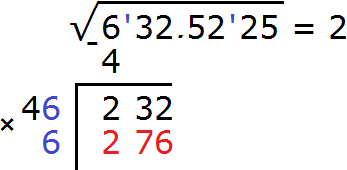
The resulting number is 276, which is greater than the remainder of 232. So the number 6 is not suitable as the second digit of the root. Let's check the number 5. Add it to number 4 and multiply the resulting number 45 by the same added digit 5
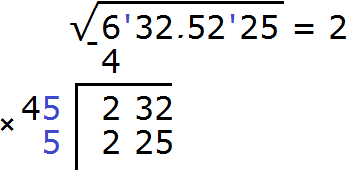
The number obtained is 225, which does not exceed the remainder 232. So the digit 5 added to the number 4 is the second digit of the root. Write it in the answer after number 2
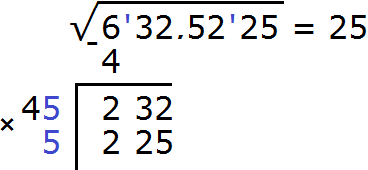
Now subtract 232 - 225 = 7.
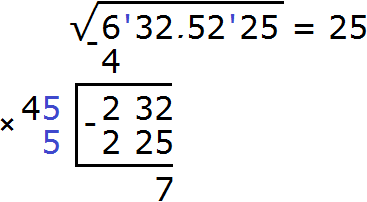
The extraction of the root from the integer part of the underlying expression is complete. At this point, we have extracted the root of 632.5225 to the nearest whole number, yielding an answer of 25. The last remainder 7 shows that the integer part of 632 exceeds the square of 252 by 7 square units.
To further extract the root (to within tenths and hundredths), take down the next facet, namely the number 52, we get the remainder 752. And in the answer after number 25 we put a point, because now we are going to look for fractional parts of the root:

Next, we work on the same principle as before. Find the first digit of the root after the point. To do this, multiply the already found digits, namely 25 by 2 to get 50. To the number 50 at the end of the need to add another digit (this figure will later be the first digit of the root after the point) and multiply the resulting number by the same added figure. The resulting product must be equal to the remainder of 752 or at least as close to it as possible, but not exceeding it.
So, for example, let's check the number 2. Add it to the number 50 and multiply the resulting number 502 by the same added digit 2. You can intuitively see that the number 2 is big because 502 × 2 = 1004. And the number 1004 is greater than the remainder of 752. Then it is obvious that the first digit after the point will be the digit 1

Now subtract 752 - 501 = 251. Immediately we take down the next face 25. The remainder is 25125.

Now find the second digit of the root after the point. Ignoring the point, multiply the found digits of the root by 2. We obtain 502.
To the number 502 at the end you need to add another digit (this digit will later become the second digit of the root after the point) and multiply the resulting number by the same added digit. The resulting product must be equal to the residue 25125 or at least as close to it as possible, but not exceeding it.
So, for example, let's check the number 6. Add it to the number 502 and multiply the resulting number 5026 by the same added digit 6. The result of multiplication will be written immediately under the remainder 25125
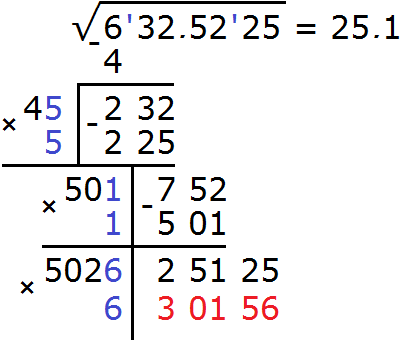
The resulting number is 30156, which is greater than the remainder of 25125. So the number 6 is not suitable as the second digit of the root after the point. Then let's check the number 5. Add it to the number 502 and multiply the resulting number 5025 by the same added digit 5
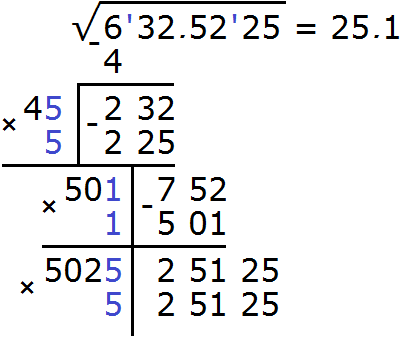
We got the number 25125, which is exactly our remainder. So the digit 5 added to the number 502 is the second digit of the root after the point. Write the digit 5 in the answer after the digit 1
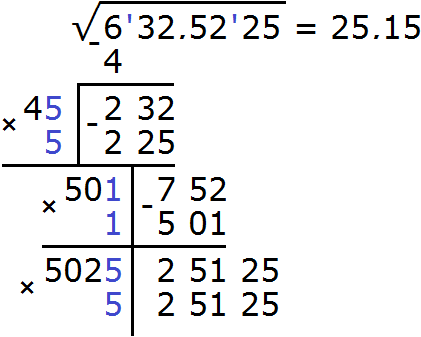
Now subtract 25125 - 25125 = 0. Zero in the remainder indicates that the solution is complete:

In this example, we could have used the method of multiplying the sub-rooted expression by 10000. Then the sub-rooted number would be 6325225. It could be divided into facets by moving from right to left. The result would be a root of 2515.

The sub-rooted number 6325225 is then divided by 10000 to return to the original number 632.5225. As a result of this division, the answer will decrease by a factor of 100 and become 25.15.
Example 6. Using the square root extraction algorithm, extract the square root of 11 to the nearest thousandths:
This number has only one facet 11. Extract the root from it to integers, we get 3
![]()
Now square the number 3 and write the result under the first facet (under the number 11)

Subtract 11 - 9 = 2
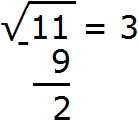
The extraction of the root from the integer part of the underlying expression is complete. At this point, we have extracted the root of the number 11 to the nearest whole number, yielding an answer of 3. The last remainder of 2 shows that the integer part of 11 exceeds the square of 32 by two square units.
Our task was to extract the root of the number 11 to the thousandths. So we need to take down the next facet, but there isn't one in this case.
If you put a dot after an integer and write as many zeros as you want, the value of that number will not change. Thus, after 11 you can put a dot and write several zeros (several facets), which can then be taken down to the remainder.
If the root is extracted to the thousandths, then the answer should have three digits after the dot. Therefore, in the sub-rooted expression we put a dot and write three facets consisting of zeros:
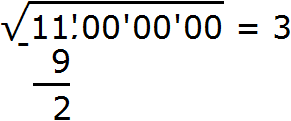
Now you can take down the next facet, namely the two zeros. We get the remainder 200. And in the answer after number 3 put a dot, because now we are going to look for fractional parts of the root:
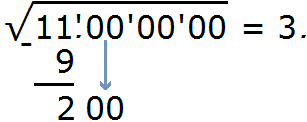
Now find the first digit after the dot in the answer. The first digit of the root, namely 3, is multiplied by 2 to obtain 6. To the number 6 you need to add another digit (this digit will later become the first digit after the dot) and multiply the resulting number by the same added digit. The resulting product should be equal to the remainder of 200 or at least as close to it as possible, but not exceeding it.
In this case, the number 3 will do.

Subtract 200 - 189, and then take down the next facet 00
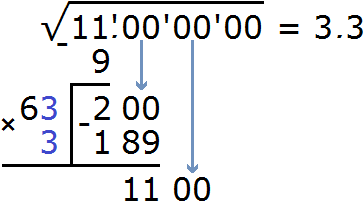
Find the second digit of the root after the dot. Ignoring the point, multiply the found digits of the root by 2. We get 66.
To the number 66 at the end you need to add another digit (this digit will later become the second digit of the root after the point) and multiply the resulting number by the same added digit. The product obtained should be equal to the remainder of 1100 or at least as close to it as possible, but not exceeding it.
In this case, the number 1 will do.
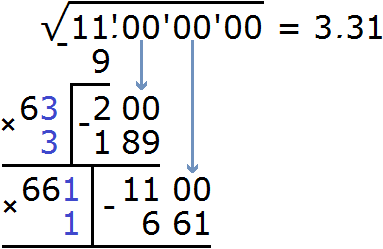
Let's subtract 1100-661 and take down the next facet 00
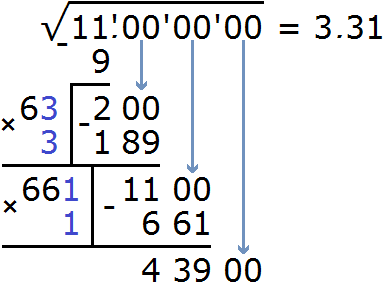
Find the third digit of the root after the dot. Ignoring the point, multiply the found digits of the root by 2. We get 662.
To the number 662 add another digit (this digit later becomes the third digit of the root after the point) and multiply the resulting number by the same added digit. The resulting product should be equal to the remainder 43900 or at least as close to it as possible, but not exceeding it.
Let's check the digit 7
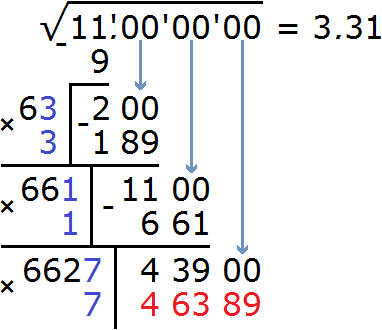
The resulting number is 46389, which is greater than the remainder of 43900. So the number 7 is not suitable as the third digit of the root after the point. Then let's check the number 6. Add it to the number 662 and multiply the resulting number 6626 by the same added digit 6
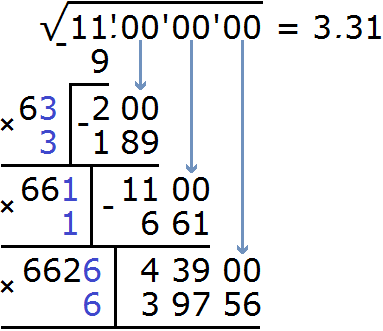
The resulting number is 39756, which does not exceed the remainder of 43900. So the digit 6 added to the number 662 is the third digit of the root after the point. Write number 6 in the answer after number 1

Subtract 43900 - 39756 = 4144
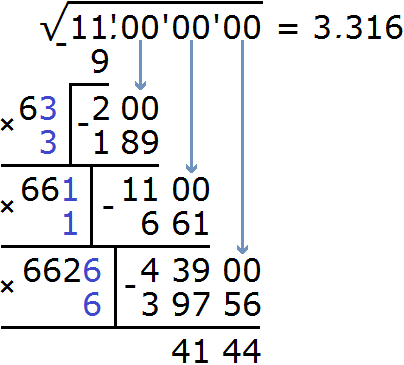
No further calculation is required, since the root had to be extracted to the nearest thousandth.
But in examples like this one, you can find the decimal point infinitely. For example, you could continue this example by finding the value of the root to the nearest ten thousandths:
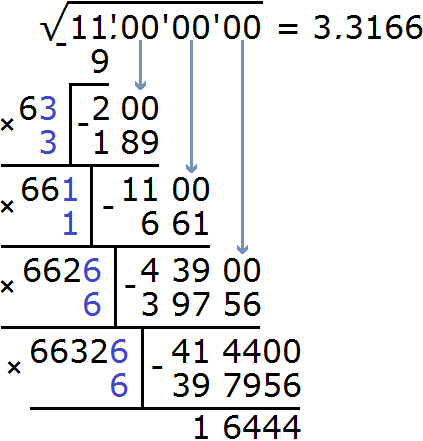
How the algorithm works
The algorithm for extracting the square root is based on the formula for squaring the sum of two expressions:
(a + b)2 = a2 + 2ab + b2
Geometrically this formula can be represented as follows:
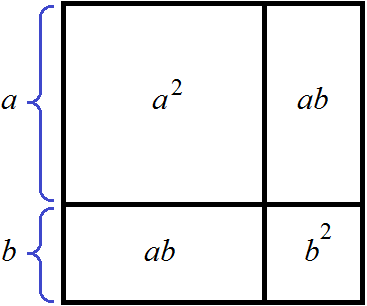
That is, the side a is increased by b. This makes the original square larger. To calculate the area of such a square, you need to separately calculate the areas of the squares and rectangles that make up this square and add up the results. You need to have a good understanding of this figure. Without understanding it it is impossible to understand how the square root extraction algorithm works.
Note that the formula for squaring the sum of two expressions allows you to square any number. Using the digits, the original number is presented as a sum of numbers and then this sum is squared.
For example, this is how you can square the number 21: represent this number as a sum of two tens and one unit, and then square this sum:
212 = (20 + 1)2 = 202 + 2 × 20 × 1 + 12 = 400 + 40 + 1 = 441
Geometrically it would look like this: the side of a square equal to 21 is divided into two components: 20 and 1.
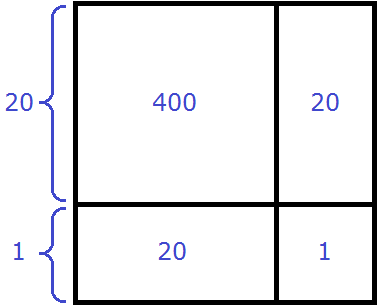
Then separately calculate the areas of the squares and rectangles included in the large square. Namely: one square with side 20 (yielding an area equal to 400), two rectangles with sides 20 and 1 (yielding two areas of 20), one square with side 1 (yielding an area equal to 1). The results of calculating the areas are added and the final value is 441.
Note also that squaring tens results in hundreds. In this case, squaring 20 results in 400. This suggests that if the root is a two-digit number, then the tens of that root should be found in the hundreds of the sub-root number. Indeed, ![]() . Root tens is the number 2, is the root of the number 4, which is responsible for the hundreds of the number 441.
. Root tens is the number 2, is the root of the number 4, which is responsible for the hundreds of the number 441.
And squaring hundreds results in tens of thousands. For example, let's square the number 123 using the formula for squaring the sum of two expressions. The number 123 is one hundred, two tens and three ones:
1232 = (100 + 20 + 3)2
While studying polynomials, we found out that if a polynomial contains more than two terms and it becomes necessary to apply the sum-square formula, then some of the terms can be bracketed to make an expression like (a + b)2

Let's look at a detailed extraction of the square root of 4096. At the same time, let's walk through the basic steps of the square root extraction algorithm discussed in the previous topic.
Suppose the number 4096 is the area of the next square:
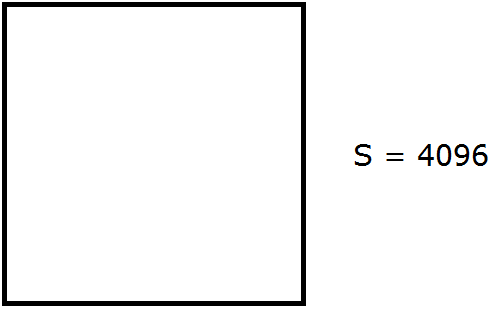
To extract the root of 4096 means to find the length of the side of a given square:
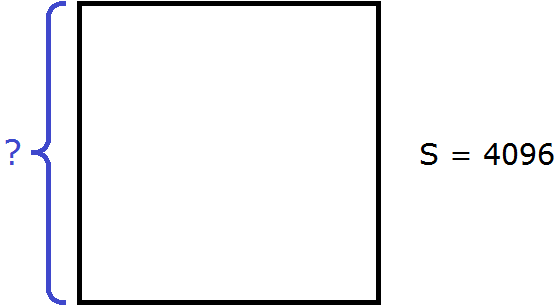
First, we find out how many digits the root will consist of. The closest known squares to 4096 are 3600 and 4900. In between is the square 4096. Let's write it as an inequality:
![]()
Write each number under the root sign:
![]()
We know the square roots of 3600 and 4900. These are the roots of 60 and 70, respectively:
![]()
The roots 60 and 70 are two-digit numbers. If the square root of 4096 is between 60 and 70, that root is also a two-digit number.
A two-digit number consists of tens and ones. This means that the square root of 4096 can be represented as the sum of a + b, where a is the tens of the root, b is the units of the root. The sum of a + b to the second power will be 4096
(a + b)2 = 4096
Then the side of the square will be divided into two components: a and b
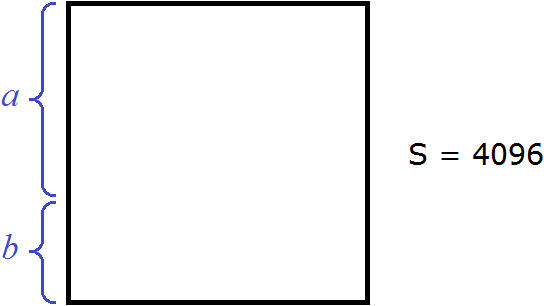
Let's rewrite the left part of equality (a + b)2 = 4096 as a2 + 2ab + b2
a2 + 2ab + b2 = 4096
Then a drawing illustrating a square with an area of 4096 can be represented as follows:

If we know the values of variables a and b, we know the length of the side of the square. Simply put, we know the root itself.
Let's go back to extracting the root. We found out that the root is a two-digit number. A two-digit number consists of tens and ones. If you squared the tens, you get hundreds. The tens of the root can be found in the hundreds of the sub-root number. There are 40 hundreds in the sub-root number. Separate them with a small notation:
![]()
Extract the root from number 40. The root cannot be extracted from number 40. Therefore, the extraction should be approximated to integers.
The closest smaller square to the number 40 is 36. Extract the root from this square and you get 6. Thus we get the first digit of the root:
![]()
In fact, the root is not extracted from number 40, but from forty hundreds. The label that comes after 40 separates the digits of the number below the root sign. It should be understood that in this case 40 is 4000.
The root cannot be extracted from 4000 as well as 40, so it must also be extracted by approximation. To do this, find the nearest least square to the number 4000. But the following should be taken into account. Tens are numbers with one zero at the end. Examples:
10 - one ten
30 - three tens
120 - twelve tens
Squaring these numbers results in numbers with two zeros at the end:
102 = 100
302 = 900
1202 = 14400
We are looking for the tens of the root in the hundreds of 4096, that is, in the number 4000. But there is no number with zero at the end whose second degree is 4000. So we are looking for the nearest smaller square, but again with two zeros at the end. This is square 3600. The root must be extracted from this square.
Let's return to our drawing. The big square with side a and area a2 is the same square 3600. Instead of a2 let's specify the value 3600

Now extract the square root from the square of 3600. Earlier we said that if a number contains a square and an even number of zeroes, we can extract the root from that number. To do this, first extract the root from the square that we already know and then write down half of the number of zeroes of the original number:
![]()
So, we found the side of a square with an area of 3600. Let us sign the side a as 60
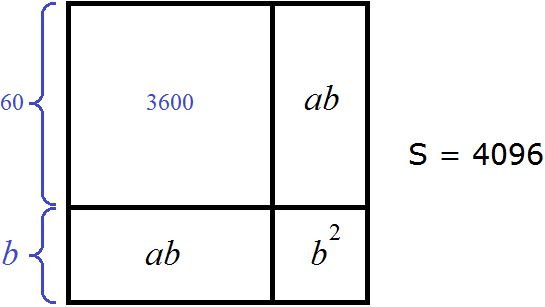
But earlier in the answer we wrote 6, not 60. This is an abbreviated version. The number 6 in this case means six tens:
![]()
So, the tens of the root are found. There are six of them. Now we need to find the units of the root. The units of the root are the length of the remaining small side of the square, that is, the value of the variable b.
To find b, subtract the square with area 4096 from the total square with area 3600. The result will be a figure whose area is 4096 - 3600 = 496
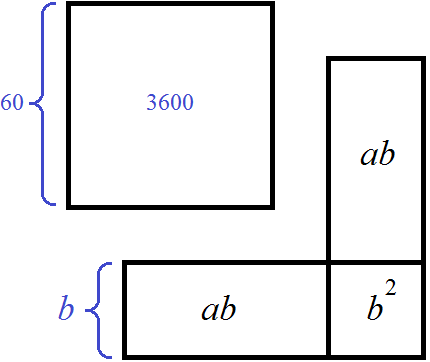
The figure shows how a square with an area of 4096 is separated from a square with an area of 3600. What is left is a figure with an area of 496.
This is why in the process of applying the algorithm, the first digit of the root found is squared to subtract the result of the square from the hundreds of sub-root expression.
Thus, 36 hundreds are subtracted from 40 hundreds, leaving four hundreds plus ninety-six units. These four hundreds and ninety-six units together make 496 units:

The remaining figure is nothing more than the doubled product of the first expression a plus the square of the second expression b
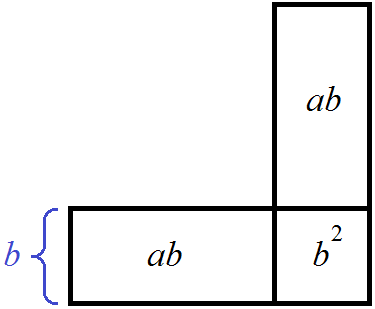
The sum of the areas 2ab + b2 must fit the number 496. Let's write it as the following equality:
2ab + b2 = 496
The value of a is already known. It is equal to 60. Then the equation will take the form:
2 × 60 × b + b2 = 496
120b + b2 = 496
Now our task is to find a value of b such that the left-hand side equals 496 or at least close to this number. Since b is the units of the required root, the value of b is a single-digit number. That is, the value of b is a number between 1 and 9. This number can be found by fitting. In this case, it is obvious that the number b is 4.
120 × 4 + 42 = 496
480 + 16 = 496
496 = 496
But for the convenience of finding this number, the variable b is put out of brackets. Let's return to the expression 120b + b2 = 496 and put b outside the brackets:
b(120 + b) = 496
Now the right part can be understood as follows: to 120 you should add some number b, which when multiplied with the same b will result in 496.
That is why, when using the algorithm, the already found number is multiplied by 2. So, we multiplied 6 by 2 and got 12, and then we added a digit to 12 and multiplied the resulting number by the same added digit, trying to get the remainder 496.

But again, this is a simplified version. In fact, not just 6 is multiplied by 2, but the found tens (in our case, the number 60), resulting in the number 120. This is followed by finding a number of the form b(120 + b). That is, the number b is added to 120, which when multiplied with b gives a remainder of 496.
So b = 4. Then:
4(120 + 4) = 496
4 × 124 = 496
496 = 496
Substituting the number 4 instead of b results in a remainder of 496. This means that the units of the root are found. A square with an area of 4096 has a side equal to 60 + 4, i.e. 64.
![]()
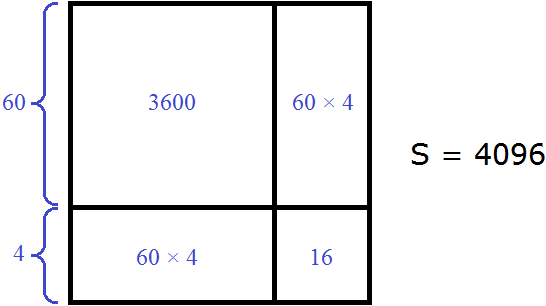
If you subtract 3600 from the total area, then 496, you get 0. The remainder, which is zero, indicates that the solution is complete:
4096 − 3600 − 496 = 0
Example 2. Extract the square root of 54756
Let the number 54756 be the area of the next square:
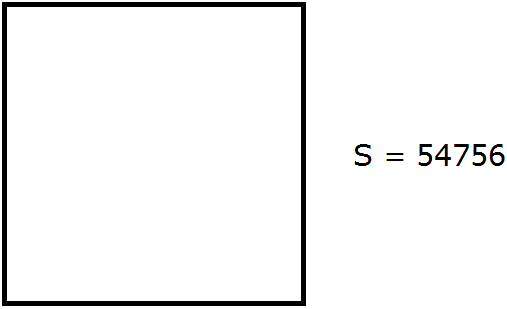
To extract the root of the number 54756 means to find the length of the side of the given square:

It is not yet known whether the square root of 54756 is an integer or a fractional number. First, let's find out how many digits make up the whole root.
The number 54756 is greater than 10000, but less than the number 900000
10000 < 54756 < 90000
The roots of 10,000 and 90000 are three-digit numbers.

Then the root of 54756 would also be a three-digit number. A three-digit number consists of hundreds, tens, and ones.
The square root of 54756 can be represented as the sum of a + b + c, where a is hundreds of the root, b is tens of the root, and c is units of the root. The sum of a + b + c to the second power would be 54756
(a + b + c)2 = 54756
Then the side of the square will be divided into three components: a, b and c
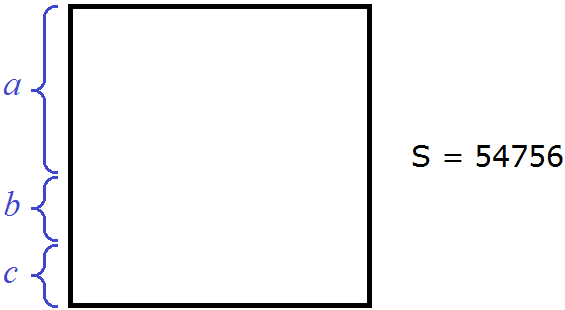
Squared the left side of the equality (a + b + c)2 = 54756:
![]()
Then the figure illustrating the square with area 54756 can be represented as follows:

Two rectangles with area ab in the above equation are replaced by 2ab, and two rectangles with area (a + b)c are replaced by 2ac + 2bc, because (a + b)c = ac + bc. If we repeat the expression ac + bc twice, we obtain 2ac + 2bc
2(ac + bc) = 2ac + 2bc
If we know the values of the variables a, b, and c, we know the length of the side of the square. Simply put, we know the root itself.
Let's go back to the extraction of the root. We found out that the root is a three-digit number. A three-digit number consists of hundreds, tens, and ones.
Squaring hundreds produces tens of thousands. Hundreds could be found in the tens of thousands of the sub-root number. The sub-root number has five tens of thousands. Separate them with a marker:
![]()
Extract the root from number 5. The root cannot be extracted from number 5. Therefore, the extraction should be approximated to integers. The nearest least square to 5 is 4. We extract the root from this square and obtain 2. This gives us the first digit of the root:
![]()
In fact, the root is not extracted from the number 5, but from five tens of thousands. The label that comes after the number 5 separates the digits of the number below the root sign. It should be understood that in this case 5 is 50,000.
The root cannot be extracted from 50,000 as well as 5, so it should also be extracted approximately. To do this, find the nearest least square to the number 50,000. But note that hundreds are numbers with two zeros at the end. Examples:
100 - one hundred
500 - five hundred
900 - nine hundred
When such numbers are squared, you get numbers that have four zeros at the end:
1002 = 10000
5002 = 250000
9002 = 810000
We are looking for hundreds of roots in tens of thousands of the number 54756, that is, in the number 50000. But there is no number with two zeros at the end whose second degree is 50000. So we are looking for the nearest smaller square, but again with four zeros at the end. This is the square of 40000.
Let's go back to our drawing. The big square with side a and area a2 is the same square 40000. Let's specify the value 40000 instead of a2

Now extract the square root of 40000
![]()
So, we found the side of a square with area 40000. Let us sign the side a as 200
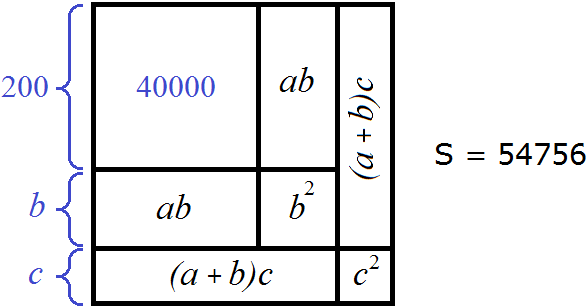
But earlier in the answer we wrote 2, not 200. This is an abbreviated version. The number 2 in this case means two hundred:
![]()
Now we pull out the remainder. Out of five tens of thousands, only four tens of thousands have the root. So there is one tens of thousands left in the remainder. Let's take it out:

Again, it must be understood that 4 is 40000 and 1 is 10000. Using the figure this can be explained as follows: the square whose area is 40000 is subtracted from the total square whose area is 54756. This leaves a figure whose area is 54756 - 40000 = 14756.
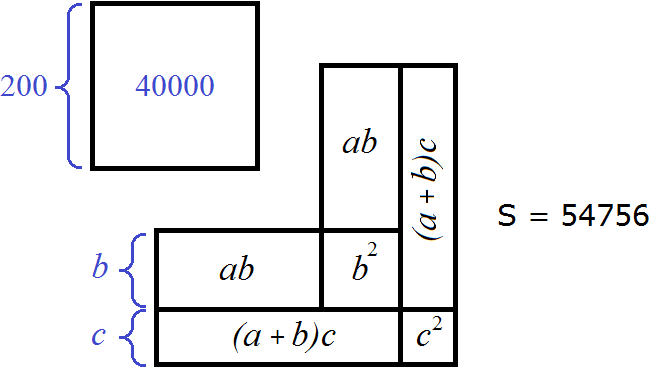
Now we need to find the tens of the root. Consider in the figure the sum of the areas ab + ab + b2 (or 2ab + b2). This sum will include one tens of thousands left over from finding the hundreds of the root, the doubled product of the hundreds and tens of the root 2ab, and the tens of the root squared by b2.
Tens squared make hundreds. Therefore, the tens of the root should be looked for in the hundreds of the sub-root number. There are now 47 hundreds under the root. Take them to remainder 1, previously separating them under the root with a marker:

One tenth of a thousand is a hundred hundreds, plus 47 hundreds taken down. The total is 100 + 47 = 147 hundreds. These 147 hundreds must include the sum 2ab + b2
2ab + b2 = 14700
The variable a is already known; it is equal to 200. Let's substitute this value into this equation:
2 × 200 × b + b2 = 14700
400b + b2 = 14700
Now our task is to find a value of b such that the left-hand side is equal to 14700 or at least close to this number, but not exceeding it. Since b is tens of the root, the value of b is a two-digit number with one zero at the end. Such a number can be found by matching. For convenience, put b in brackets on the left side
b(400 + b) = 14700
Now the left part can be understood this way: to 400 we should add some number b, which when multiplied with the same b will result in 14700 or a number close to 14700 and not exceeding it. Let us substitute, for example, 40
40(400 + 40) = 14700
17600 ≠ 14700
It turns out 17600, which exceeds the number 14700. So the number 40 is not suitable as a root tens. Let's check then the number 30
30(400 + 30) = 14700
12900 ≤ 14700
You get the number 12900, which does not exceed 14700. So the number 30 is suitable as the root tens. Numbers between 30 and 40 do not need to be checked, since we are now only interested in two-digit numbers with one zero at the end:
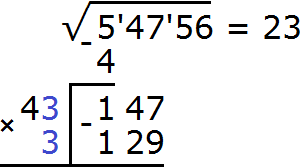
Let's go back to our drawing. The side b is the tens of the root. Let us indicate instead of b the found tens of 30. And the square whose area b2 is the found tens in the second power, that is, the number 900. Let us also specify the areas of the rectangles ab. They are equal to the product of the hundreds of the root by the tens of the root, i.e. 200 × 30 = 6000
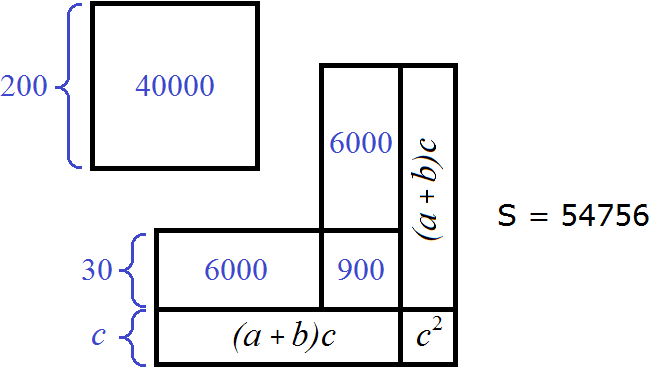
Earlier in the answer, we wrote 3 instead of 30. This is an abbreviated version. The number 3 in this case means three tens.
Now we pull out the remainder. The 147 hundredths only fit 129 hundredths. So the remainder is 147 - 129 = 18 hundreds plus we take down the number 56 from sub-root expression. The result is a new residue of 1856
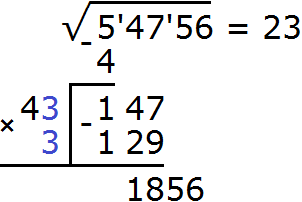
This can be explained using the figure as follows: From the figure, the area of which is 14756, subtract the area of 12900. This leaves a figure whose area is 14756 - 12900 = 1856.
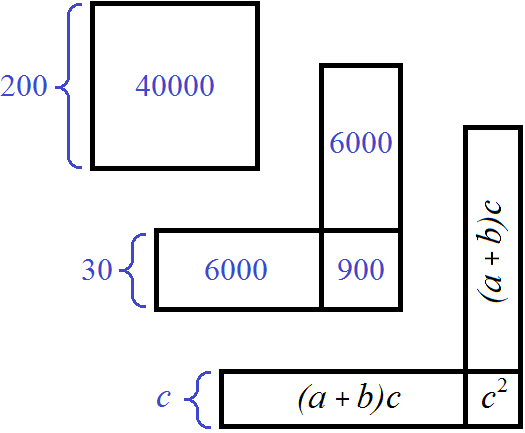
Now we need to find the units of the root. Consider in the figure the sum of the areas 2(a + b)c + c2. This sum should include the last residue 1856
2(a + b)c + c2 = 1856
Variables a and b are already known; they are 200 and 30, respectively. Substitute these values into this equation:
2(200 + 30)c + c2 = 1856
2 × 230c + c2 = 1856
460c + c2 = 1856
Now our task is to find a value of c such that the left part becomes equal to 1856 or at least close to this number, but not exceeding it. Since c is the units of the required root, the value of c is a single-digit number. That is, the value of c is a number between 1 and 9. This number can be found using the fitting method. For convenience, put c in brackets on the left side
с(460 + c) = 1856
Now the left part can be understood this way: some number c must be added to 460, which when multiplied with the same c will result in 1856 or a number close to 1856 and not exceeding it. For example, let us substitute the number 4
4(460 + 4) = 1856
4 × 464 = 1856
1856 = 1856
That's why when using the algorithm, the first digits found are multiplied by 2. So, we multiplied 23 by 2, got 46, and then added a digit to 46 and multiplied the resulting number by the same added digit, trying to get the remainder 1856
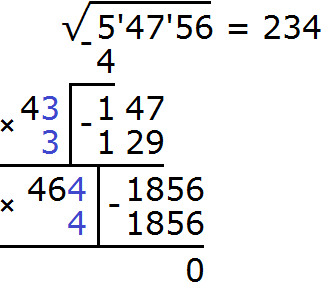
So, c = 4. Substituting the number 4 in place of c yields a remainder of 1856. This means that the units of the root are found.
A square with area 54756 has a side equal to 200 + 30 + 4, i.e. 234.
![]()
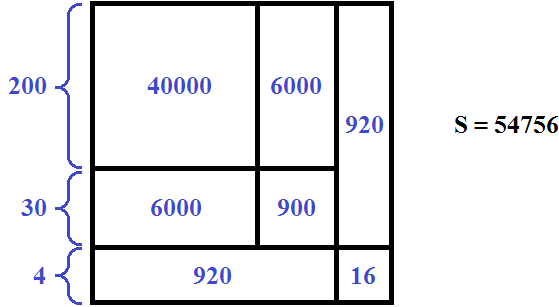
If you subtract 40000, 6000, 6000, 900, 920, 920 and 16 from the total area of 54756, you get 0. A residue equal to zero indicates that the solution is complete:
54756 − 40000 − 6000 − 6000 − 900 − 920 − 920 − 16 = 0
Example 3: Extract the square root of 3
The square root of number 3 cannot be extracted. Earlier we said that square roots from such numbers can only be extracted approximately to a certain accuracy.
Let 3 be the area of the next square:
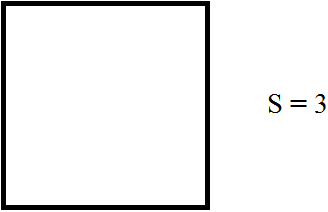
To extract the root of 3 is to find the length of the side of a given square:
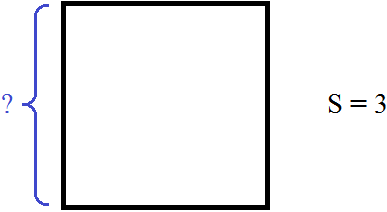
The root of 3 is greater than the root of 1, but less than the root of 4
√1 < √3 < √4
The roots of 1 and 4 are integers.
√1 < √3 < √4
1 < √3 < 2
There are no integers between numbers 1 and 2. So the root of number 3 is a decimal. Find this root to the nearest tenth.
The square root of number 3 can be represented as a + b, where a is the integer part of the root and b is the fractional part. Then the side of the square can be divided into two components: a and b

The sum of a + b in the second power must approximate 3.
(a + b)2 ≈ 3
Squared the left side of this equality:
a2 + 2ab + b2 ≈ 3
Then the figure illustrating the square of area 3 can be represented as follows:
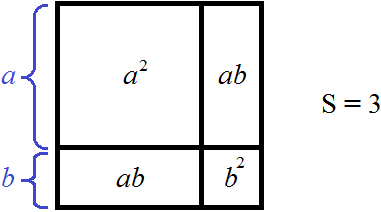
Find a. Extract the root of number 3 to integers, we get 1
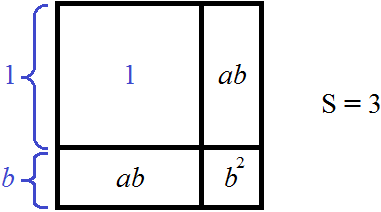
If a2 is 1 and the area of the whole square is 3, then the remainder should contain 2. This remainder should contain the area of the remaining figure:
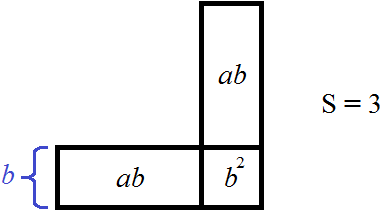
Let's find b. To do this, consider the sum of the areas 2ab + b2. This sum should approximately equal to the residue 2, but not exceed it
2ab + b2 ≈ 2
The value of a is already known, it is equal to one:
2b + b2 ≈ 2
Let's take b out of brackets
b(2 + b) ≈ 2
Now add some number b to 2 on the left side, which when multiplied with the same b will approximately equal 2.
The value of b is a fractional number, namely the tenth part. It is equal to any number from the interval [0,1; 0,9]. Take any number from this interval and substitute it into the equation. For example, let's substitute 0.8
0.8(2 + 0.8) ≈ 2
2.24 ≈ 2
The result is 2.24, which exceeds 2. So 0.8 is not suitable as the value of b. Let's check 0.7 then.
0.7(2 + 0.7) ≈ 2
1.89 ≈ 2
The result is 1.89, which is approximately equal to 2 and does not exceed it. So 0.7 is the value of b
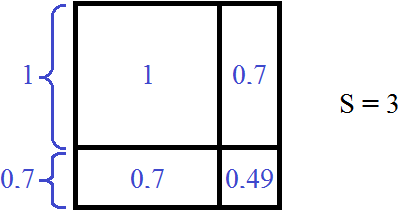
So the square root of 3 is approximately 1 + 0.7 to the nearest tenth.
![]()
Unfortunately, understanding the mechanism of the square root extraction algorithm is much harder than using the algorithm itself. Solve a few examples on how to use the algorithm, and understanding the mechanism of its operation will be much easier for you.
Tasks for independent decision

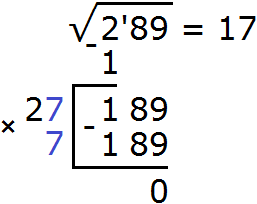
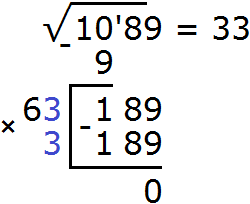
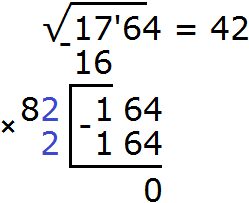

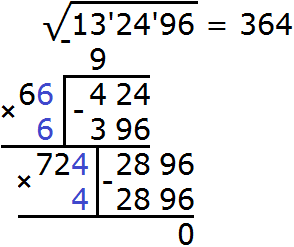
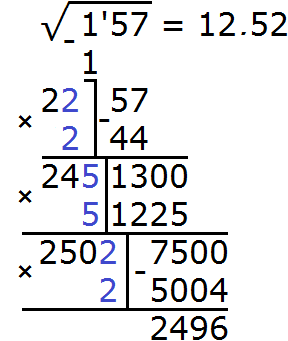
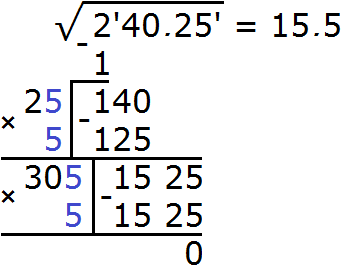
Comments